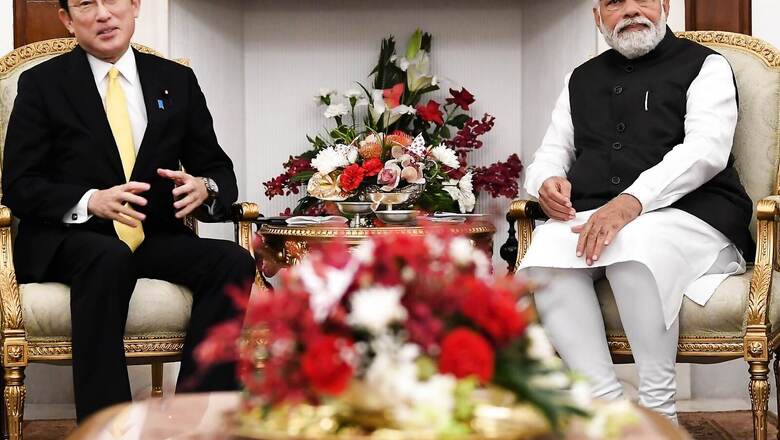
views
There are few bilateral relationships that are as dispute-free as the one between India and Japan. The Japanese see India as the land of Lord Buddha and Subhash Chandra Bose, which is why they have a lot of respect for Indians. India, on the other hand, looks towards Japan as a developed, benevolent power that can help lend stability to the Indo-Pacific. Therefore, the relationship between India and Japan is based on mutual understanding and mutual admiration.
After the 1950s, the bilateral relationship between the two countries has remained stable. A diplomatic relationship was established in 1952, Japan started providing soft loans and developmental aid to India in 1958 and when India faced a balance of payment crisis in 1991, Japan was one of the few countries that helped New Delhi. However, over the past few years, the relationship has evolved further and has become more strategic in character. So, how is the Indo-Japanese relationship evolving and what does it mean for the two countries? Let’s find out.
The Indo-Japanese relationship is evolving in three areas- the Indian Ocean Region (IOR), defence and economic partnership. Cooperation in each of these three sectors is strategically crucial for the three countries.
Starting with cooperation in the Indian Ocean Region, Recently, the Japan International Cooperation Agency (JICA) signed a grant agreement with the Government of India to provide around US$133 million for a power supply project in India’s Andaman & Nicobar Islands (ANI). For India, the investment becomes pivotal to its plans of developing the Islands into a well-equipped region where military assets can be effectively stationed. The islands carry a lot of significance being located close to the Strait of Malacca and accounting for 30% of India’s Exclusive Economic Zone (EEZ) in the Indian Ocean Region, which New Delhi considers to be its privileged sphere of influence.
Also Read: Japan and Australia Back India’s Push Against Biden’s Derailment of The Quad
This is however just one of many such Japanese investments in the region. Japan has also been making strategic investments in countries like Nepal, Sri Lanka and Bangladesh. This gives India a sense of security in the region. Even if China is trying to ramp up investments in the region, India can take heart from the fact that its partner, Japan is also getting involved in the region.
For Japan, investments in the Indian Ocean Region mostly revolve around energy security. Tokyo imports 90% of its fuel from the Middle East. India too exports refined petroleum and other energy commodities to Japan. However, Japan must ensure the safety of the critical sea lines of communication in the Indian Ocean in order to secure its energy supplies. With China ramping up its presence in the region and emergence of non-conventional security threats such as trafficking and smuggling, Tokyo is also moved by self-interest in its attempts to ensure a comprehensive presence in the Indian Ocean Region.
Together, both India and Japan are looking to ensure that other regional actors like Malaysia, Myanmar, Thailand and Indonesia, all of which are located in close vicinity to the Andaman & Nicobar Islands are assured that the Quad still exercises a lot of influence. The US may have dropped the ball with the Solomon Islands signing a defence deal with Beijing, but the other three Quad nations- India, Australia and Japan aren’t going to sit idle.
Also Read: China Spreads its Tentacles in Australia’s Backyard as the World Looks Away
Meanwhile, India and Japan have also expanded cooperation in the defence sector. The two countries have developed several frameworks to enhance defence dialogue including Foreign and Defence Ministerial Meeting (“2+2” meeting), annual Defence Ministerial Dialogue and the Malabar Exercise. In 2020, New Delhi and Tokyo signed the “Acquisition and Cross-Servicing Agreement (ACSA)” that paves way for establishing “a framework such as the settlement procedures for the reciprocal provision of supplies and services between the Self-Defense Forces of Japan and the Indian Armed Forces” to “facilitate the smooth and prompt provision of supplies and services between the Self-Defense Forces of Japan and the Indian Armed Forces.”
The defence pact is a signal of converging geopolitical interests. Both India and Japan face Chinese military aggression, and therefore the two sides can counteract China with greater cooperation and sharing of military resources.
Finally, India and Japan are evolving their economic partnership. Japan has always taken a keen interest when it comes to investing in India’s infrastructure through soft loans or aid grants. India has benefitted from Japanese-funded projects like the Delhi Metro and there are several such ongoing projects too including the Mumbai-Ahmedabad High-Speed Rail, the Western Dedicated Freight Corridor (DFC), the Delhi-Mumbai Industrial Corridor and the Chennai-Bengaluru Industrial Corridor (CBIC).
The Japanese perceive India as a great friend and a means of counterbalancing growing Chinese influence, which explains why Tokyo has invested billions of Dollars in India over the past six decades or so. Recently, during his India visit, Japanese PM Fumio Kishida announced a plan to invest 5 trillion yen ($42 billion) in India over the next five years, surpassing the 3.5 trillion yen that former Japanese PM Shinzo Abe had offered in 2014.
However, the Indo-Japanese relationship is now moving beyond aid assistance and development of infrastructure. Tokyo has been continuously signalling that many Japanese companies are ready to invest in India provided the conditions are conducive. Remember, India, Japan and Australia had launched the Supply Chain Resilience Initiative (SCRI) last year in a bid to move regional and global supply chains away from China. For India, this is an opportunity to ramp up its manufacturing industry while competing more fiercely with China and for Japan, it is an opportunity to decouple more vigorously from China.
Japan also signed a Memorandum of Cooperation (MoC) with India, under which skilled Indian workers from fourteen sectors- nursing care; building cleaning; material processing industry; industrial machinery manufacturing industry; electric and electronic information related industry; construction; shipbuilding and ship-related industry; automobile maintenance; aviation; lodging; agriculture; fisheries; food and beverages manufacturing industry and food service industry, were identified for enhanced job opportunities in Japan.
The MoC is extraordinary in the sense that Japan is a closed society and generally reticent about immigration. However, the Japanese perceive Indians as bright, intelligent and belonging to the land of Lord Buddha. Therefore, assimilation of Indian workers in Japanese society would be comparatively easier.
For the people of India, it translates into an opportunity to target a new jobs market. On the other hand, Japan can solve its workforce scarcity issue by tapping into India’s young demographic advantage. For many Japanese corporations relocating their operations from China to their home location, the arrival of skilled Indian workers could be a major shot in the arm.
India and Japan remain time-tested partners and their evolving relationship reflects the growing convergence of their strategic interests.
Read all the Latest Opinions here



















Comments
0 comment